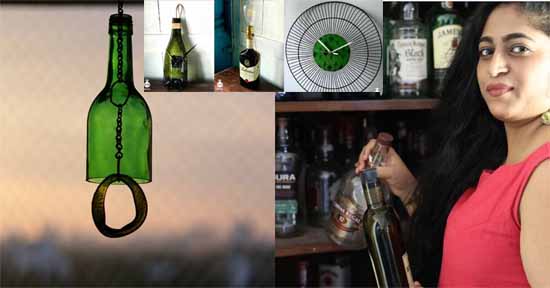By Tina Freese
Renjini Thomas turned her love for art into the sustainable venture Vapasee, wherein she upcycles discarded glass bottles into stunning home decor items, preventing thousands of pieces from entering landfills.
What happens to the glass bottles that your favourite sauces and cold drinks come in, once you throw them away? You might think they end up in recycling bins, but this is not entirely true.
As per a Green Sutra report, India produces 3 million tonnes of glass waste every year. Out of this, only 45 percent is recycled, while the rest ends up in landfills. For most of us, glass bottles are a waste. But for this 35-year-old Renjini Thampi, they’re treasures to be cherished.
A chime to add a zen-like charm to your home as it dances in the breeze!
.
.
.#ecofriendly #upcycled #bottlegreen #upcyclekochi #vapasee #productvideo #windchimes #balconydecor #zengarden #zenlifestyle #windyday #upcycledglassbottle #upcycledwinebottles pic.twitter.com/nXT1LZw2aA— Vapasee (@vapaseeindia) March 3, 2021
When Renjini came to India from Dubai in 2015 after getting married, she saw the potential to create art in waste glass.
“Back when I was in Dubai, I never thought of what happened to waste. But, when I came to India and saw so much waste being generated, I thought, why not create something good out of it?,” she shares with The Better India.
With her startup Vapasee, she has upcycled more than 21,000 glass bottles into items of home decor and art pieces. These include lamps, side table decorations, wall hangings, pallets, clocks, and more.
A turn of events
Rejini, who completed her education in Dubai, returned to Kochi after marriage. Of her growing years in Kerala, she says, “Although I have an artist’s demeanour and passion, my life and career have been a mix of things. While I studied finance, I never worked in the field. I worked in aviation and then in the media industry,” she shares. “Even as a child, I was very interested in art and painting. I got tutored in painting, but mostly looked at it as a hobby back then.”
“When I moved to India, it felt like a nice opportunity to take a break from work. I decided to pursue my interest in art instead,” she says.
She continues, “Additionally, I got married into a home where a lot of people were into different forms of art. My husband is also an artist, so I gained a lot of exposure. He has a studio where he produces sound for movies. But back in Dubai, the scenario was completely different. People around me were not too much into art. I was also a little tired of my 9 to 5 schedule. ”
When Renjini came to India, she had the perfect opportunity to nurture her love for art. She tried to create a community of art lovers by hosting exhibitions of her paintings. “When I started painting, I thought why not showcase them in exhibitions? I had a few in Chennai, which were quite appreciated,” she says.
Looking for a purpose for her art also led Renjini to realise the potential of waste materials. “For my husband’s sound studio, we used to visit scrap dealers so that he can find old instruments or items he needed for his studio. This is when I saw so much waste just lying there, with no use but a lot of potential,” she says.
Her artistic instincts kicked in and she decided to make use of the huge amount of glass waste lying with scrap dealers.
“Some of the materials that the scrap collectors received would sell for a lot of money, for instance copper. But there were some that were of no use to them. Those materials would just end up in landfills. Glass was one of those. The scrap dealers gave it to me for free. I also started collecting things like tire rims, buckets, glass, and tin cans.”
With the collected waste, Renjini would make home decor pieces for her house and her friends. “They would not believe that the pieces were made out of discarded waste. I would make small home decor items, tables and centrepieces for them. They really appreciated it and asked me to make some business out of this hobby.”
She started taking on-demand orders from friends and family who wanted to re-furnish their homes, taking token money for her art.
Sustainable, up cycled and Eco-friendly
Soon, Renjini started getting more and more requests and in 2021, she started her brand Vapasee.
“The journey to Vapasee was also quite a surprise for me. I mostly focused on the art side of things. While I was making pieces out of pieces that would otherwise end up in landfills, I was more concerned about the art side of it,” she says.
In 2020 she came across Climate Collective, an organisation that promotes sustainable business and advocates action for climate change.
“I got into Climate Collective’s launch pad. They were in Kochi for the Women Entrepreneur for climate change competition. It was for entrepreneurs like us who had eco-friendly startup ideas. They saw the potential of my work and guided me to create more environmental impact by saving more glass bottles from ending in landfills and making my business model more profitable.”
Without any experience in business, Renjini reached the India semi-finals of the launch pad.
“My mentor asked me to apply for IIM- Bengaluru’s programme for the incubation of startups. I applied and got selected. Until the pre-incubation programme, I had my doubts and kept thinking that I just got lucky. But when I was selected, I realised that there is so much potential for upcycled products,” she explains, adding she learnt all the aspects of the business from IIM-Bengaluru.
The true potential of waste
With Vapasee, Renjini makes a range of home decor products such as bowls, centrepieces, tables, lamps, and art pieces. She says she has saved over 21,000 glass bottles from ending up in landfills by upcycling them.
She collects glass from scrap dealers and through collection drives. In these collection drives, she asks people to bring their glass waste and give them to her.
Talking about working with glass, Renjini says, “Glass can be risky to work with, as it requires a lot of patience to learn the whole process. I visited many people in the field of glass making and tried to learn the trade. The material is very fragile and cracking the code of how much heat the glass can take before it melts or breaks was hard. But with trial and error and help from some of the people in the field, I now can make most products without any hiccups.”
Besides glass, she has upcycled more than 5,000 coconut shells, over 800 kg of wood, and more than 500 kg of metal waste to make items of home decor and art pieces. She has sold over 5,000 such products so far.
Anasuya Sreedhar, a Mumbai resident who purchased a lamp from Renjini, says, “When the finest Scotch bottle becomes a gorgeous lamp, you know whose work that might be! I purchased the lamp from her Instagram page and no one could ever guess it was made of waste glass. The piece is stunning with gorgeous details, and the best part is that [it was] sustainable and upcycled. It always catches my guests’ eye.”
Most of Renjini’s products are available through her official Instagram account and websites such as Amazon, Brown Living, Loopify, Refash, Onegreen, and Magikelf etc. The company’s website will soon be live too.
“The kind of appreciation I received for my art became my motivation. I was never very confident about my work, but when I got into IIM – Bengaluru, it gave me the required confidence to keep going. Vapasee, as the name signifies, comes from the Hindi word vapsi, which means to return. The idea is that the discarded waste that leaves one person’s home comes back to another household after we up cycle it,” she says.
(This report is auto-generated from The Better India, . Dainik Hind mitra holds no responsibility for its content.)

















